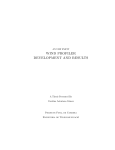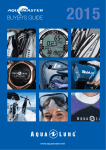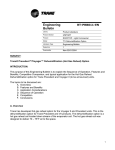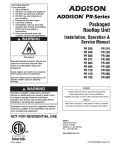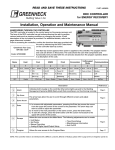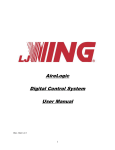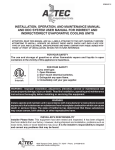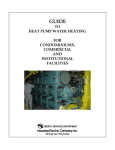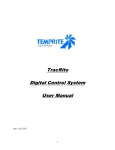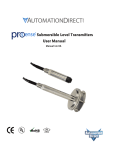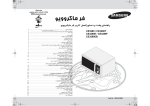Download SEQUENCE OF OPERATION FOR ALC CONTROL www.addison
Transcript
ADDISON ® SEQUENCE OF OPERATION FOR ALC CONTROL AIRSOURCE COOLING-ONLY 100% OUTSIDE AIR VERSION 2.0 www.addison-hvac.com Telephone: +1.407.292.4400 1 SEQUENCE OF OPERATION The ALC controller is turned on by a switch located on its front upper left corner. Several options exist for starting the unit, such as the Resident Program Scheduler or the Building Automation System. These control source options can be selected from the BACview display pad on the Configuration Set-Up screen (requires Admin password). The Resident Program has an adjustable scheduler that uses the internal time clock to allow for separate Sequences for Occupied and Unoccupied periods. This can be accessed from the BACview display pad on the Schedules screen (requires user password). NOTE: All temperature-related events have an additional “delay on make” to allow temperatures to settle. OCCUPIED MODE: When the program control source calls for the start of the Occupied Mode, the ALC controller verifies that there are no fault or shutdown conditions, a delay timer begins after which the unit goes into Occupied Mode: 1.Outdoor Air Damper (OD): • After the unit goes into Occupied Mode, the OA damper will open. As the OA damper opens, the Outdoor Air Damper Actuator (OADA) auxiliary switches close. 2.Supply Fan (SF): • As the OA damper opens, the OADA auxiliary switch (adjustable) will close and the SF will turn on. • The SF shall operate continuously while the unit is in the Occupied Mode. When the system reaches the end of the Occupied Mode period, the SF will continue to run for an additional 2 minutes before turning off. • SF-VFD: Supply Fan Variable Frequency Drive. • The SF-VFD will modulate its speed based upon the differential pressure transmitter (SF-DPT) signal to maintain the supply duct static pressure set point. • For contact air volume (CAV), select “Manual Override” in the BACview keypad and input the required speed (Hz) per field test and balance. 3.Exhaust Fan (EF): • At the same time the SF turns on, the EF, if included, will turn on. • The EF shall operate continuously while the unit is in the Occupied Mode. When the system reaches the end of the Occupied Mode period, the EF will continue to run for an additional 2 minutes before turning off. • EF-VFD: Exhaust Fan Variable Frequency Drive. • The EF-VFD will modulate its speed based upon the differential pressure transmitter (EF-DPT) signal to maintain the building static pressure set point. For contact air volume (CAV), select “Manual Override” in the BACview keypad and put the required speed (Hz) per field test and balance. 2 4.Energy Conservation Wheel (ECW): • As the OA damper opens, the OADA auxiliary switch (fixed) closes which enables the Johnson Controls C450 controller. At this point, the wheel operates as an independently controlled component. A separate OAT and RAT sensors are wired directly to the Johnson Control C450. • Wheel Standard Operation: • When the OAT is above or below an adjustable differential (3° F [1.7° C]) of the return air temperature (RAT), the Wheel will be on, otherwise it is off. • Wheel with On/Off Defrost: • When the OAT is above or below an adjustable differentia (3° F [1.7° C]) of the return air temperature (RAT), the Wheel will be on. It will be off if the OAT is within the differential range or below an adjustable set point to allow for wheel defrosting (default is 15° F [-9.4° C]). • Wheel with VFD Controlled Defrost (WM-VFD): • When the OAT is above or below an adjustable differential (3° F [1.7° C]) of the return air temperature (RAT), the Wheel will be on. It will slow its speed or stop if the OAT is below an adjustable set point to allow for defrosting default is 15° F (-9.4° C). It will be off if the OAT is within the RAT differential range. 5.Cooling Mode: • When the Outdoor Air Temperature, OAT (Entering Coil Air Temperature, ECAT, if wheel exists) is above the leaving air temperature (LAT) cooling set point (72° F [22.2° C], adjustable), compressor #1 turns on. When OAT (ECAT, if wheel exist) is 1° below the LAT set point, cooling modes is off. • For systems with two compressors, when the LAT is above the LAT cooling set point plus an adjustable differential (2° F [1.1° C]), compressor #2 turns on. • Compressor enabling logic includes a 4-minute minimum run-time and a 5-minute minimum time-off delay. • Digital Compressors: • When unit has hot gas Reheat, the digital compressors will modulate (load and unload) based on the suction line temperature (SLT) set point (45° F [7.2° C], adjustable). • When unit has no hot gas Reheat, the digital compressor will modulate (load and unload) based on the leaving air temperature (LAT) cooling set point. • If the SLT drops to 32° F (0.0° C) or less, the digital compressor will run fixed at 10%. • For systems with two digital compressors, when there is a call for 1st stage cooling, 2nd stage cooling will also be enabled 10 seconds later. Both compressors will modulate to maintain the set point. • For systems with two compressors, if there is a current call for 1st stage cooling and compressor #1 is shut down due to an alarm (HP1, LP1, or SLT1), compressor #2 will be turned on to take its place until it returns. • Hot Gas Reheat (HGRH) – On/Off: • When the LAT is 1° F (0.6° C) (adjustable) below the LAT cooling set point, Reheat turns on and cycles to maintain the LAT set point. • When the LAT is 2° F (1.1° C) (adjustable) above the LAT cooling set point, HGRH turns off. • Hot Gas Reheat (HGRH) – Modulating: • When the leaving air temperature is 1° F (0.6° C) (adjustable) below the LAT cooling set point, Reheat turns on and modulates to maintain the LAT cooling set point. • When the LAT is 2° F (1.1° C) (adjustable) above the LAT cooling set point, Reheat turns off. 6.Dehumidification Mode: • When OAT (ECAT, if wheel exists) is more than 60° F (15.6° C) and the zone relative humidity (Z-RH) is 1%RH above the Z-RH set point, 55%RH (adjustable) and there is no call for heating, Dehumidification Mode is enabled. After the minimum time-off delay, compressor #1 turns on. • For systems with two compressors, when the Z-RH is 2%RH (adjustable) above the Z-RH set point, after the minimum time-off delay, compressor #2 turns on. Both compressors will respond in sequence and run at full cooling. • Reheat is enabled to operate as necessary to maintain the LAT cooling set point. • When the Z-RH is 2%RH (adjustable) below the Z-RH set point, the Dehumidification Mode is disabled. • Digital Compressors: • The digital compressors run at 100% capacity when there is a call for dehumidification. • During dehumidification mode, if the SLT drops to 38° F (3.3° C) or less, the digital compressor will modulate from 100% (for SLT of 38° F [3.3° C]) down to 10% (for SLT of 32° F (0.0° C). Operation at 32° F (0.0° C) or less will be the same as during normal cooling mode operation. • For systems with two digital compressors, both compressors will turn on and run at 100% capacity. • Hot Gas Reheat (HGRH) – On/Off: • When the LAT is below the LAT cooling set point, Reheat turns on and cycles to maintain the LAT set point. • When the LAT is 2° F (1.1° C) (adjustable) above the LAT cooling set point, HGRH turns off. • Hot Gas Reheat (HGRH) – Modulating: • When the LAT is below the LAT cooling set point, Reheat turns on and modulates to maintain the LAT cooling set point. • When the LAT is 2° F (1.1° C) (adjustable) above the LAT cooling set point, HGRH turns off. 7.Room Temperature Reheat Override (RTRHO) Optional: • Room Temperature Reheat Override mode is selectable using the BACview display pad or BAS, and operates in cooling mode and dehumidification mode when Reheat is included (default is “OFF”). • When Reheat is on and the zone air temperature (ZAT) is above the ZAT cooling set point, 72° F (22.2° C) (adjustable), the LAT cooling set point will decrease by a ratio and decrease Reheat modulation (or turn off Reheat, if On/Off control) in order to lower the ZAT. When the ZAT equals the ZAT cooling set point, the unit will go back to normal cooling mode with LAT control. • When the ZAT is below the ZAT cooling set point, the LAT cooling set point will increase by a ratio, turn on Reheat (if off ), and increase Reheat modulation (if included) in order to raise the ZAT. When the ZAT equals the ZAT cooling set point, the unit will go back to normal cooling mode with LAT control. 8.Heating Mode: • When the Outside Air Temperature, OAT (Entering Coil Air Temperature, ECAT, if wheel exists) is 1° F (0.6° C) below the OAT (ECAT, if wheel exists) enabling heating set point, 55° F (12.8° C) (adjustable), heating is enabled and modulates to maintain LAT heating set point, 72° F (22.2° C) (adjustable). • When the OAT (ECAT, if wheel exists) is 1° F (0.6° C) (adjustable) above the OAT (ECAT, if wheel exists) enabling heating set point, heating is disabled. Staged Heat (Electric Heat or Gas Furnace): • 2-Stage Heat: Terminal W1 turning on enables first-stage heating. As the LAT goes further below the LAT heating set point, terminal W2 energizes 3 and second-stage heating is enabled. As the LAT rises, second-stage heating turns off. As the LAT goes above the LAT heating set point, terminal W1 turns off and first-stage heating turns off. • 4-Stage Heat: Terminal W1 turning on enables the heating analog relay module (HARM) on the control panel which activates the different stages of heating. As the LAT goes further below the LAT heating set point, the different stages will turn on. As the LAT goes further above the LAT heating set point, the different stages will turn off. • Modulating Heat: • SCR Electric Heat: On demand for heating, the electric heating SCR will modulate in order to maintain the LAT heating set point. • Modulating Gas Heat: On demand for heating, the gas furnace controller will modulate to control the gas flow in order to maintain the LAT heating set point. • Room Temperature Heating Override - Optional: • Room Temperature Heating Override mode is selectable using the BACview display pad or BAS, and operates in heating mode when included (default is “OFF”). • When the zone air temperature (ZAT) is 2° F (1.1° C) (adjustable) below the ZAT heating set point, the LAT heating set point will increase by a ratio and increase heat modulation in order to raise the ZAT. When the ZAT is equal to or more than the ZAT heating set point, the unit will go back to normal heating operation. • When the ZAT is 2° F (1.1° C) (adjustable) above the ZAT heating set point, the LAT heating set point will decrease by a ratio and decrease heat modulation in order to lower the ZAT. When the ZAT is equal to or less than the ZAT heating set point, the unit will go back to normal heating operation. UNOCCUPIED MODE: • When the system has reached the end of its Occupied Mode, the compressor(s) and outdoor fan(s) (subject to minimum run-time) or heating system will turn off. The SF and EF (if existing) will continue to run for 2 minutes before turning off. After this, the Wheel (if existing) will turn off and the OA damper will close. • Unit is now off. Safety Switches: • High Pressure Switch (HP): If HP1 is open, the ALC controller will issue an alarm and compressor #1 is turned off and locked out. After resetting HP1, the compressor lock-out can be reset in the BACview display pad or by cycling the power of the ALC controller. 4 • For systems with two compressors, this sequence is the same for compressor #2, Y2 and HP2. Low Pressure Switch (LP1): If LP1 is open after the LP1 by-pass time, the ALC controller will issue an alarm and compressor #1 turns off. After 30 seconds (fixed), the LP1 alarm will reset. Following a minimum time off delay, compressor #1 will turn on. If the ALC controller records 3 low pressure start/restart failure incidents within 1 hour, compressor #1 is locked out and the ALC controller will issue an alarm. The compressor lock-out can be reset in the BACview display pad or by cycling the power of the ALC controller. • For systems with two compressors, this sequence is the same for compressor #2, Y2 and LP2. Safety Shutdown: • Smoke Detector: When a smoke detector (SD) is provided, it is wired directly to the ALC controller. If smoke is detected, the ALC controller will shut down the unit. The alarm can be reset in the BACview display pad or by cycling the power of the ALC controller. • If a compressor fails to start 3 times in an hour due to low pressure switch lock out. The alarm can be reset in the BACview display pad or by cycling the power of the ALC controller. • If the SLT drops to 28° F (-2.2° C) or less for 15 minutes, the ALC controller will issue an alarm and compressor stops. When the SLT warms back to 50° F (10.0 ° C) or more, compressor turns back on. If a compressor fails to start 3 times in an hour due to low suction line temperature, compressor will be locked out. The alarm can be reset in the BACview display pad or by cycling the power of the ALC controller. • If the ALC controller detects an LAT sensor failure. The alarm can be reset in the BACview display pad or by cycling the power of the ALC controller. Standard Alarms: (alarms require reset in the BACview or cycling the power of the ALC controller unless noted) 1. Supply Fan Alarm: If the SF fails to start and the SF-APS (air proving switch) does not confirm air flow to ALC; following 60 second (adjustable) delay. Unit will automatically shut down. 2. Exhaust Fan Alarm: If the EF fails to start and the EF-APS (air proving switch) does not confirm air flow to ALC; following 60 second (adjustable) delay. 3. Compressor #1/#2 Fault: Compressor stops due to HP1/HP2 open; following 30 second (fixed) delay. Requires HP1/HP2 manual reset. 4. Low Pressure Switch #1/#2 Alarm: Compressor stops due to LP1/LP2 open; following 90 second (adjustable) delay. Compressor lock out occurs if alarm happens 3 times in 1 hour (Low Pressure Switch #1/#2 STOP). 5. SLT #1/#2 Alarm: Compressor stops due to SLT1/ SLT2 freeze condition; following 15 minute (adjustable) delay. Compressor lock out occurs if alarm happens 3 times in 1 hour (SLT #1/#2 STOP). 6. Sensors readings exceeding limits, following 2 minute (fixed) delay. Alarms reset automatically. a. ECAT Sensor Failure – if wheel exists; Open: -60.2° F (-51.2° C), Short: 296° F (146.7° C). b. EC-RH Sensor Failure – if wheel exists; Open: 0%, Short: > 100%. c. SLT1 Sensor Failure – Open: -60.2° F (-51.2° C), Short: 296° F (146.7° C). d. SLT2 Sensor Failure – Open: -60.2° F (-51.2° C), Short: 296° F (146.7° C). e. OAT Sensor Failure – if no wheel exists; Open: -60.2° F (-51.2° C), Short: 296° F (146.7° C). f. OA-RH Sensor Failure – if no wheel exists; Open: 0%, Short: > 100%. g. ZAT Sensor Failure – Open: < 45.1° F (7.3° C), Short: > 98° F (36.7° C). h. Z-RH Sensor Failure – Open: 0%, Short: > 100%. 7. LAT Sensor Failure: Open: -60.2° F (-51.2° C), Short: 296° F (146.7° C). Unit will automatically shut down. 8. High LAT Alarm: LAT high limit, 120° F (48.9° C) (adjustable) with Electric Heat. Alarm resets automatically. 9. High LAT Alarm: LAT high limit, 130° F (54.4° C) (adjustable) with Gas Furnace Heat. Alarm resets automatically. 10. Low LAT Alarm: LAT low limit, 40° F (4.4° C) (adjustable), following 15 minute (adjustable) delay. Unit will automatically shut down. 11. Clogged Filter Alarm: Clogged filter indicator (CFI), following 2 minute (fixed) delay. Alarm resets automatically. 12. Heat Failure: In heating mode and the LAT falls below 50° F (10.0° C) (adjustable), following 15 minute (adjustable) delay. Alarm resets automatically. 13. Smoke Detector Alarm: If smoke is detected, following 30 second (fixed) delay. Unit will automatically shut down. 14. Set Point Overlap Alarm: If OAT cooling and heating set points are selected such that the ranges overlap. Alarm logic will reset modified set points to previous value. Alarm resets automatically. 5 THANK YOU FOR YOUR BUSINESS 7050 Overland Road Orlando, FL 32810 U.S.A. Telephone: +1.407.292.4400 Fax: +1.407.290.1329 www.addison-hvac.com Installation Code and Quarterly Inspections: All installation and service of ADDISON® equipment must be performed by a contractor qualified in the installation and service of equipment sold and supplied by Addison and conform to all requirements set forth in the ADDISON® manuals and all applicable governmental authorities pertaining to the installation, service, operation and labeling of the equipment. To help facilitate optimum performance and safety, Addison recommends that a qualified contractor conduct quarterly inspections of your ADDISON® equipment and perform service where necessary, using only replacement parts sold and supplied by Addison. Further Information: Applications, engineering and detailed guidance on systems design, installation and equipment performance is available through ADDISON® representatives. Please contact us for any further information you may require, including the Installation, Operation and Service Manual. This product is not for residential use. This document is intended to assist licensed professionals in the exercise of their professional judgment. © 2013 Addison Printed in the USA All rights reserved. No part of this work covered by the copyrights herein may be reproduced or copied in any form or by any means - graphic, electronic, or mechanical, including photocopying, recording, taping or information storage and retrieval systems - without the written permission of Addison. ADSOOASCBNA 1013 Orig






